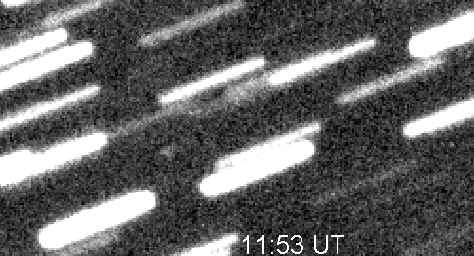
|
Image of Dawn Spacecraft 600,000 miles From Earth
- Click the image above for a larger view
 Movie Download Options
Movie Download Options- Full-Res JPEG (500 x 270) (33.6 kB)
- Full-Res TIFF (500 x 270) (135.4 kB)
Caption:
This animation is a blinking of two 14-minute exposures of the Dawn spacecraft from 600,000 miles from Earth. Bill Dillon, a regular advanced user of Sierra Stars Observatory , used the Sierra Stars Observatory telescope to image the Dawn spacecraft early in October, 2007. The spacecraft was only 20th magnitude and moving fast. Dawn was in a fairly crowded star field at the time, but, fortunately, the spacecraft was not hidden behind stars.
Background Info:
The Dawn mission to Vesta and Ceres is managed by JPL, a division of the California Institute of Technology in Pasadena, for NASA's Science Mission Directorate, Washington. The University of California, Los Angeles, is responsible for overall Dawn mission science. Other scientific partners include Planetary Science Institute, Tucson, Ariz.; Max Planck Institute for Solar System Research, Katlenburg-Lindau, Germany; DLR Institute for Planetary Research, Berlin; Italian National Institute for Astrophysics, Rome; and the Italian Space Agency. Orbital Sciences Corporation of Dulles, Va., designed and built the Dawn spacecraft.
Cataloging Keywords:
| Name | Value | Additional Values |
|---|---|---|
| Target | 1 Ceres | 4 Vesta |
| System | Main Belt | |
| Target Type | Dwarf Planet | Asteroid |
| Mission | Dawn | |
| Instrument Host | Dawn | |
| Host Type | Orbiter | |
| Instrument | ||
| Detector | ||
| Extra Keywords | Grayscale, Movie | |
| Acquisition Date | ||
| Release Date | 2009-05-29 | |
| Date in Caption | ||
| Image Credit | NASA/JPL/Bill Dillon | |
| Source | photojournal.jpl.nasa.gov/catalog/PIA12016 | |
| Identifier | PIA12016 | |
